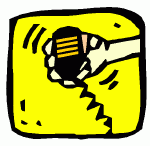 Go Ahead and Use Phonetics on 2m FM
Go Ahead and Use Phonetics on 2m FM
 Sometimes radio amateurs suggest that phonetics are not needed on VHF FM. (See examples here and here.) Sometimes it even sounds like it’s a bad thing to use phonetics on FM. It is inefficient and slows things down. I can see the logic behind this because with decent signal strength, demodulated FM audio is usually quite clear and easy to understand.
Sometimes radio amateurs suggest that phonetics are not needed on VHF FM. (See examples here and here.) Sometimes it even sounds like it’s a bad thing to use phonetics on FM. It is inefficient and slows things down. I can see the logic behind this because with decent signal strength, demodulated FM audio is usually quite clear and easy to understand.
Here’s what I wrote in my VHF FM Operating Guide, also downplaying the need for phonetics:
The use of phonetics is not usually required due to the clear audio normally associated with frequency modulation. Still, sometimes it is difficult to tell the difference between similar sounding letters such as “P” and “B”. Under such conditions, use the standard ITU phonetics to maintain clarity. Many nets specifically request the use of standard phonetics to make it easier on the net control station.
The FCC Technician exam gives the topic of phonetics a light touch with just these two questions:
T1A03 (D)
What are the FCC rules regarding the use of a phonetic alphabet for station identification in the Amateur Radio Service?A. It is required when transmitting emergency messages
B. It is prohibited
C. It is required when in contact with foreign stations
D. It is encouraged
And this one:
T2C03 (C)
What should be done when using voice modes to ensure that voice messages containing unusual words are received correctly?A. Send the words by voice and Morse code
B. Speak very loudly into the microphone
C. Spell the words using a standard phonetic alphabet
D. All of these choices are correct
Use Phonetics
In practical radio operating, there are a number of things that can degrade communication, usually by creating noise sources that compete with the voice modulation. Most of these are a factor even if the RF signal is strong:
- A noisy environment at the receiving end (e.g., background noise such as road noise in an automobile)
- A noisy environment at the transmitter (e.g., background noise such as wind noise outdoors)
- Poor frequency response of the overall system (e.g., high frequencies may be lost in the transmitter, receiver or repeater, making it more difficult to understand the voice communication).
- Hearing impairment of the person receiving the audio (I’ve heard that we are all getting older)
- Difficulty understanding the person speaking (poor enunciation, unfamiliar dialect or accent, etc.)
So I say go ahead and use phonetics on VHF FM, especially for critical information such as your call sign. FM communication is not always clear and easy to understand. It suffers from the same signal-to-noise problems as other voice modes. (Perhaps not as bad as SSB on HF, but it’s still a factor.) In most cases, you’ll want to stick with the standard ITU phonetic alphabet (also known as the NATO alphabet).

Many nets request that you use ITU phonetics when you check in. Imagine being the Net Control Station for a net and having everyone making up their own phonetics. You would have call signs coming at you with all kinds of random words associated with them. It is much better to have consistency. However, there are times when you might want to use alternative phonetics. See the HamRadioSchool.com article: Phonetic Alphabets for more insight on that.
73, Bob
Kilo Zero November Romeo
The post Go Ahead and Use Phonetics on 2m FM appeared first on The KØNR Radio Site.













Phonetics IS FINE WITH ME BECAUSE SOME PEOPLE SOUND LIKE THEIR EATING THE MIC.
Younger hams,especially girls speak faster then I DRIVE LOL
bob af2dx
I have used the phonetic alphabet at work, over the telephone, for years. When giving and receiving alpha numeric serial numbers, part numbers, and other identifiers, there is no room for error.
Bob above has a good point. Too many newer hams talk straight into the mic and the speech is concussive and ‘windy’. I try to gently suggest they place the mic (or portable) at the corner of their mouth and talk across the front of it.
Far as phonetics, sometimes I’m flummoxed by the words people use for some letters. I’m sure it’s amusing to them but not always helpful to the other (me) guy.
Lowell
NE4EB
As far back as I can remember, from early AM days—it was always a good Phone operating procedure to use the right phonetics–today its even more important when not much importance is being paid to good communication quality audio with right articulation of speech–HI-FI audio is ok when you talking across town with a couple of KWs or you 59+ 60 db all the time !
I have found great problems when people come up on Satellite FM & race along giving their call without phonetics, not realising, its actually more delay & missing out on a complete QSO because of repeating QRZ.